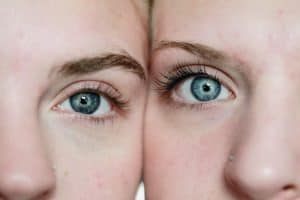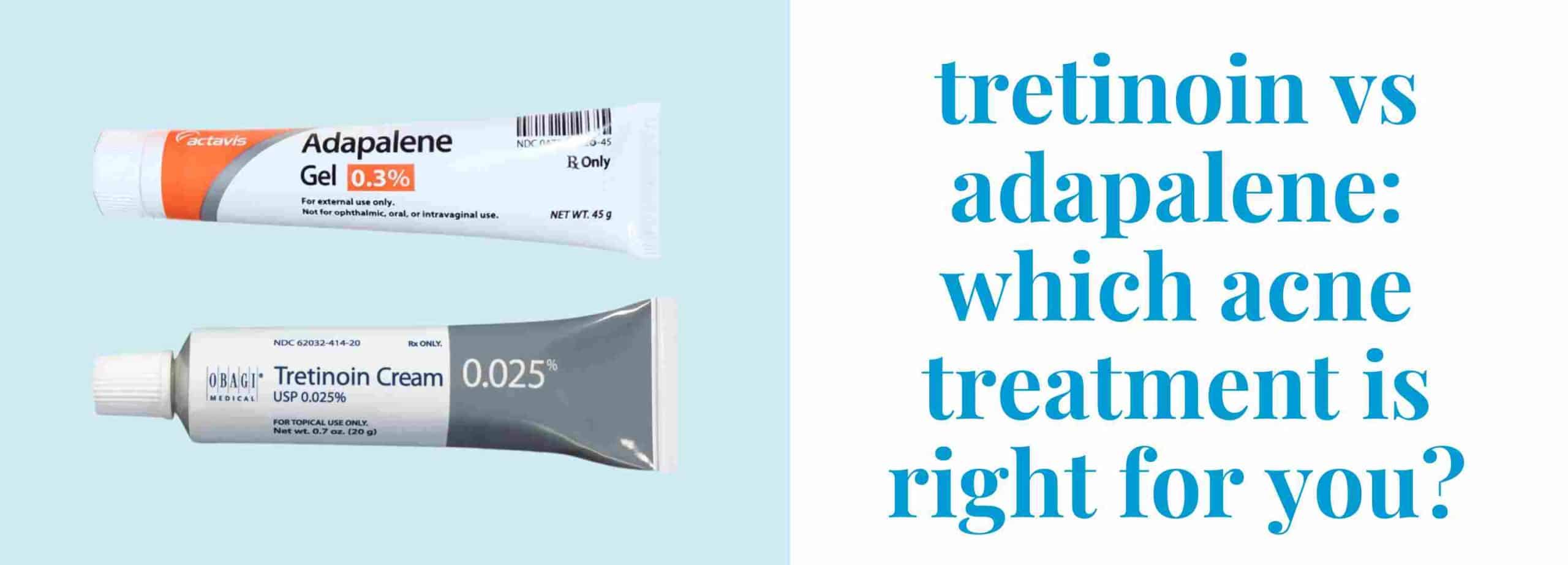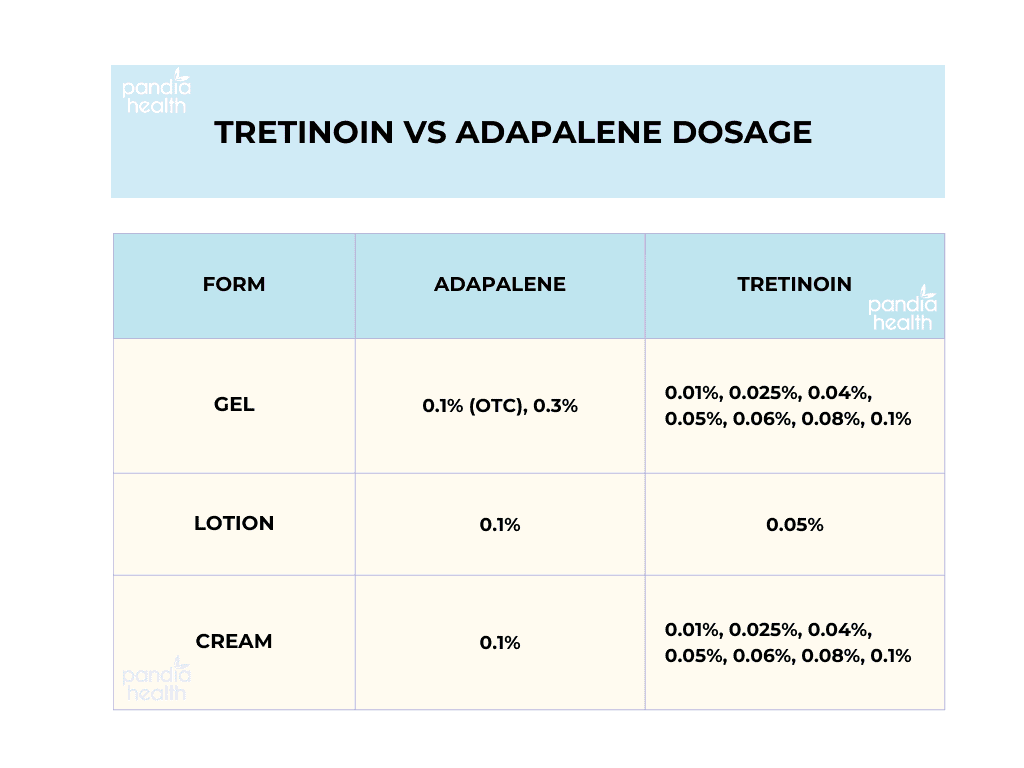Medically reviewed by Sophia Yen, MD, MPH
If you’re dealing with acne, you may have heard of tretinoin and adapalene. Both are topical retinoids that can be used to treat acne, but they have some differences in how they work and the types of acne they are best suited for. In this article, we’ll discuss tretinoin vs adapalene and help you determine which acne treatment might be right for you.

What’s the Difference Between Adapalene and Tretinoin?
While both adapalene and tretinoin work similarly to improve acne by increasing cell turnover and preventing the formation of new acne, there are some differences between them.
Adapalene is a newer retinoid that is more gentle and less irritating to the skin than tretinoin. It is available over the counter at lower strengths, while stronger formulations require a prescription.
Tretinoin, on the other hand, has been used for acne treatment for several decades and is more potent/strong. It is available in various strengths and formulations, including creams, gels, and microspheres but all of them require a prescription.
Adapalene Uses
As we mentioned before, Adapalene is a retinoid (derivative of vitamin A). Among its FDA approved uses are to:
- Treat acne: Adapalene helps to clear existing acne lesions and prevent the formation of new pimples, blackheads, and whiteheads.
- Prevent acne: Adapalene can also be used as a maintenance therapy to prevent the recurrence of acne after the initial treatment phase. It helps to keep the pores small and prevent the formation of new acne lesions.
- Acne scarring: Adapalene may also be used to improve the appearance of acne scars. It helps by promoting skin cell turnover and stimulating collagen production, which can lead to smoother and more even-looking skin.
Tretinoin Uses
Tretinoin, same as Adapalene, is a retinoid but we can find more uses (FDA-approved) such as to treat:
- Acne vulgaris: Tretinoin is commonly used to treat mild to moderate acne vulgaris. It works by promoting the shedding of dead skin cells, unclogging pores, and reducing oil production. It helps to clear existing acne lesions, prevent the formation of new pimples, blackheads, and whiteheads, and improve overall skin texture.
- Acne scarring: Tretinoin is also used to improve the appearance of acne scars. It helps promote skin cell turnover and stimulate collagen production, which can lead to the gradual fading of acne scars and the improvement of overall skin texture.
- Photoaging and wrinkles: also used to improve the appearance of skin affected by photoaging, including fine lines, wrinkles, and uneven skin tone. It stimulates collagen production and increases skin cell turnover, leading to smoother and more youthful-looking skin.
- Hyperpigmentation: Tretinoin may be used to lighten areas of hyperpigmentation, such as age spots, sunspots, and melasma. It helps to reduce the production of melanin, the pigment responsible for darkening the skin, leading to a more even complexion.
- Rough skin texture: Tretinoin can improve the texture of rough or uneven skin by promoting the exfoliation of dead skin cells and encouraging the growth of new skin cells. It can help to soften the skin and make it appear smoother and more refined (smaller pores).
Dosage
Adapalene and Tretinoin are available in different forms (gel, lotion, cream) and dosages (see table below). When starting a new acne treatment you will often start from lower strengths and go up to higher strengths as needed. Your doctor will guide you in the journey and adapt the treatment to your skin needs.
In the US, all forms of Tretinoin are only available with a doctor’s prescription. On the other hand, Adapalene has an over the counter option available (which means no prescription/provider visit is needed to get this lower strength version of adapalene).
Know that adapalene 0.1% gel is NOT equivalent to tretinoin 0.1% gel and that 0.1% GEL is not equivalent to 0.1% cream. For acne, gel is stronger than cream.
Side effects of tretinoin and adapalene
Side effects of tretinoin
Tretinoin is a powerful medication that can be effective in treating acne, but it can also cause some side effects. The most common side effects of tretinoin include dryness, redness, peeling, and skin irritation. These side effects can be mild or severe, depending on the person and the strength of the medication.
In some cases, tretinoin can cause more serious side effects such as blistering, crusting, and severe itching. It can also cause sun sensitivity, so it is important to use sun protection when using tretinoin, specifically sun block and/or hats. Additionally, tretinoin should not be used during pregnancy because theoretically could cause harm the developing fetus.
If you experience any side effects while using tretinoin, it is important to talk to your healthcare provider. They may be able to adjust the dose or recommend a different medication. It is also important to follow the instructions for use carefully and to use tretinoin as directed.
Side effects of adapalene
The most common side effects of adapalene include skin dryness, redness, itching, and scaling. These side effects are usually mild and temporary and can be managed with proper skincare. In rare cases, adapalene can cause severe allergic reactions, which can cause swelling, itching, and difficulty breathing. If you experience any of these symptoms, you should seek medical attention immediately.
Adapalene can also make your skin more sensitive to sunlight, so it is important to use sunscreen and avoid excessive sun exposure while using this medication.
Get a Prescription for Tretinoin Online
In the U.S., you can only obtain tretinoin with a prescription from a doctor. Our expert doctors at Pandia Health can prescribe tretinoin if you're a good candidate based on your skin type and acne concerns. You can get your prescription from the comfort of your home, delivered right to your mailbox. Get started today!
Why Both Adapalene and Tretinoin Are Leading Acne Treatments
Despite the tretinoin vs. adapalene debate, both medications are leading acne treatments because they help clear existing acne and prevent new acne from developing. There’s a time and a place for both, depending on your skin sensitivity and the degree/severity and type of acne you’re treating.
Which one provides better results on acne?
Both adapalene and tretinoin are effective treatments for comedonal acne, which is acne that’s closer to your skin’s surface — think blackheads and whiteheads. These medications work by speeding up cell turnover and preventing the formation of new comedones.
However, if you’re suffering from inflammatory acne, tretinoin is your best bet. Because tretinoin has a stronger anti-inflammatory effect, it can help to clear up existing acne and prevent new inflammatory acne from forming.
If you’re struggling with acne, it’s important to consult with an expert doctor who can help you determine the best treatment plan for your specific skin acne concerns.
Acne treatment benefits
Tretinoin and adapalene are both very effective in treating acne. One study found that over 70% of patients improved their acne after using adapalene or tretinoin, but the main difference between the two was that the tretinoin patients showed increased skin sensitivity.
Both adapalene and tretinoin work by increasing the turnover of your skin cells. When cells turn over faster, pores are unclogged. This prevents new acne from forming. They also help to reduce inflammation, which can help to reduce the size and redness of existing acne.
Anti-aging benefits
Both adapalene and tretinoin are known for their anti-aging benefits in addition to their acne-fighting properties. Adapalene can help reduce the appearance of fine lines and wrinkles by increasing collagen production in the skin.
Tretinoin also stimulates collagen production and can improve skin texture, tone, and reduce the appearance of sun damage. However, it’s important to note that consistent use is key when it comes to seeing the anti-aging benefits of these treatments.
Get Expert Advice from Pandia Health
If you’ve been debating tretinoin vs. adapalene and are considering adapalene as a treatment for your acne, it’s important to consult with a qualified doctor so you’re starting with the right strength for your unique case of acne. Consult one of our expert doctors at Pandia Health and learn the best option for you!
Which one is cheaper?
The cost of Tretinoin and Adapalene can vary depending on the brand, strength, and whether the manufacturer is running a deal or coupon. At Pandia Health we have affordable prices and take most forms of insurance and we offer FREE delivery for the medications! Though most insurance requires a copay at least and sometimes they don’t cover the medications, depending on your age.
Can I Use Adapalene and Retinol Together?
It’s not recommended to use adapalene and retinol, tretinoin together. They are the same family/mechanism, using two of them is like using twice as much and they can cause irritation and dryness.
When it comes to using any retinoid, less is more. Keep it simple and stay consistent, and you’ll normally start to see results in about eight-twelve weeks.
Always consult your doctor before you combine retinoids with other retinoids or strong ingredients like acids. Acids can inactivate retinoids. Check your toners, too — some exfoliating toners contain strong ingredients that may worsen the dryness and redness you may experience when using retinoids.
Get the Best Treatment Option with Pandia Health
It can be overwhelming to navigate the world of acne products and treatments. That’s where the expert doctors at Pandia Health come in. Our team of board-certified doctors can help you determine the best treatment option for your unique skin concerns, whether it be adapalene, tretinoin, or something else. After a consultation with one of our doctors, you’ll get your prescription acne treatment delivered straight to your door every month, with free shipping and goody included! Get started with Pandia Health today!
Pandia Health is dedicated to providing accurate, reliable women’s health knowledge. Check us out on Instagram, TikTok, YouTube, and our other social channels for expert insights about acne treatments, women’s health, and lifestyle habits.
Disclaimer: This article is for general informational purposes and is NOT a substitute for professional medical advice. Always seek the advice of your healthcare provider before starting or changing acne treatment.



